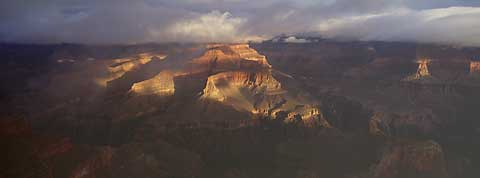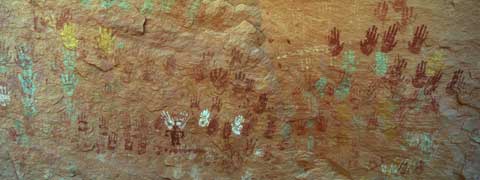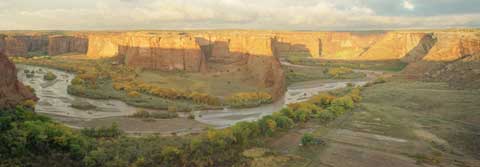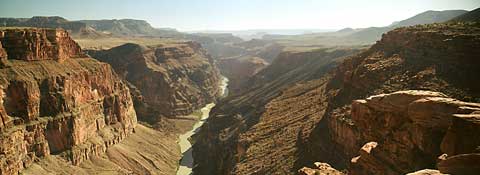Panoramics
All Text and Photographs Below are by Alain Briot
 Storm at Sunrise from Hopi Point, Grand Canyon National Park, Arizona, 1998
Storm at Sunrise from Hopi Point, Grand Canyon National Park, Arizona, 1998
This image was taken about an hour after sunrise in December 1998. On this cold winter morning sunrise was bright and clear but soon afterwards a storm started moving over the Grand Canyon from the Southwest. The huge chasm started to fill with fog leaving only enough openings in the clouds for patches of light to break through and illuminate the countless buttes, mesas and plateaus which form the Grand Canyon. in active weather conditions, with the fog patterns continuously changing in front of my eyes, I took a number of exposures using the 90mm lens of my Fuji 6×17. I eventually selected this image as most representative of what I saw and felt this morning.
 Handprint pictographs, Navajoland
Handprint pictographs, Navajoland
This large collection of handprints is found in a cave where many other pictographs (painted images) are located. Clearly this location had particular meaning for the Anasazi Indians who created these paintings before their culture vanished 700 years ago. To create the handprints the Anasazi covered the palm of their hands in paint and then pressed them on the canyon walls.
Handprints are common in the Southwest but to find them in this quantity and with such a high level of preservation is unusual. When I first visited this location (whose exact whereabouts are kept confidential for fear of vandalism) I first believed they had been created by teenagers a few days ago! The green color is so vivid as to make them look fluorescent. There is also a small anthropomorph (man-shaped figure) with two hands imprinted above his head. Although I prefer to stay away from interpreting these images it is possible that this represents a sign of respect for the individual depicted there.
 Sunset from Tsegi overlook, Canyon de Chelly National Monument.
Sunset from Tsegi overlook, Canyon de Chelly National Monument.
Tsegi overlook is only a 10 minute drive from my house making it my favorite close-to-home location. I go there on a regular basis, sometimes as a way to relax and enjoy a beautiful sunset after a long day at work (doing photography but not photographing). Sunset is a spectacular natural event there when the skies are clear. This view faces North-East, so the sun when the photo was taken was behind me and to my left. The panoramic format is the only way to get this photograph framed the way I want it and before I owned (or even knew about the existence of) the Fuji 6×17 camera I would regularly splice together two wide-angle 35mm photographs or use a fish-eye lens photograph cropped at the top and bottom. Living in Chinle I have met several of the Navajo residents who own property at the bottom of Canyon de Chelly. This photograph is thus quite meaningful to them, not only or so much because of the quality of the light or because of the composition, but because it shows their land.
This view was taken on a late June afternoon with the Fuji 6×17 and the 90mmm lens. The view and the light were fantastic but there was a strong wind which precluded using a tripod (the wind was strong enough to make it difficult for me to stand up). However, once in a while the wind would stop for a second or so offering a brief opportunity to photograph. I thus decided to use the camera hand-held. I was using Agfa Ultra 50 negative film and at full aperture was able to set the speed at 1/60th of a second, enough to keep the image sharp. Most of the image being focused at infinity, only the rocks on the right side are out of focus. Since then I have used the 6×17 hand held quite often, preferably with faster-speed film.
I have had great success with Kodak T400CN black and white film which is developed in C41 process. With 400 speed film I am able to use a relatively small f-stop in afternoon photographs thus providing me with a reasonable depth of field. Unless I use a foreground element, most of my panoramic photographs are taken at infinity thus requiring minimal or no depth of field. Due to its width and light weight (the camera is made of plastic composite material while the lenses have metal barrels) I find the 6×17 to be relatively easy to balance and use hand held.
By total coincidence contributorsAlain BriotandJames Chowas well asMichael Reichmannall useFuji 617panoramic cameras. Considering how rare these cameras are this says something (but it’s unclear what) about the way these three photographers work.
An essay by Alain on why he uses theFuji GX617panoramic format camera can be foundhere.
All text and photographs on this page are Copyright © 1991 – 1999 by Alain Briot
This is one of a regular series of exclusive articles byAlain BriotcalledBriot’s View

